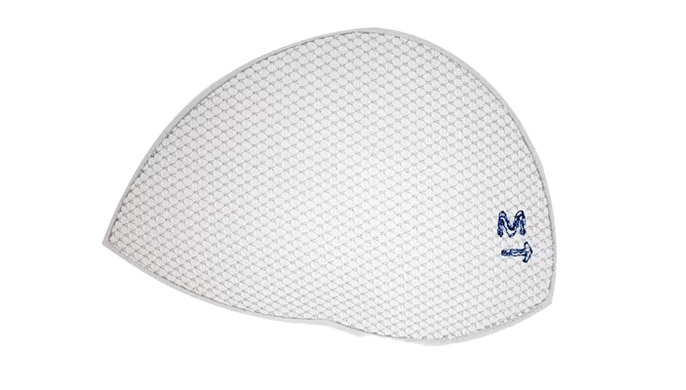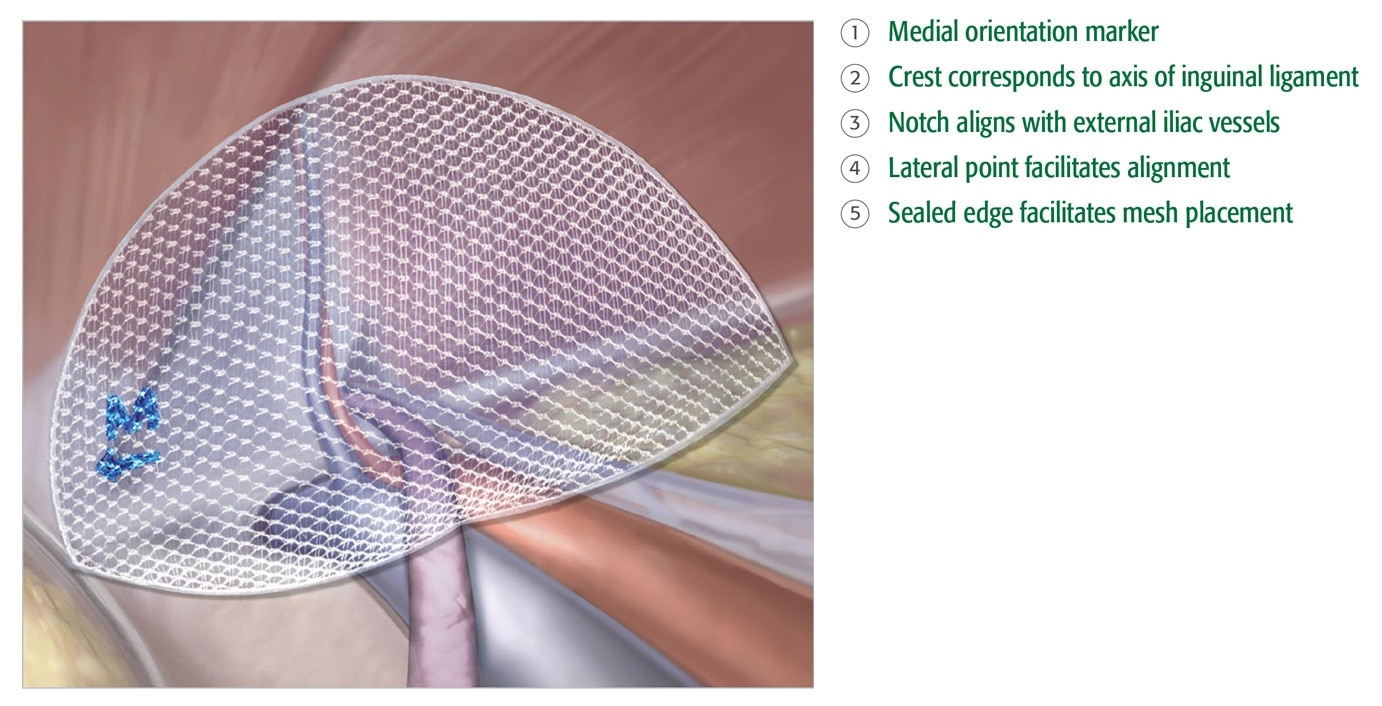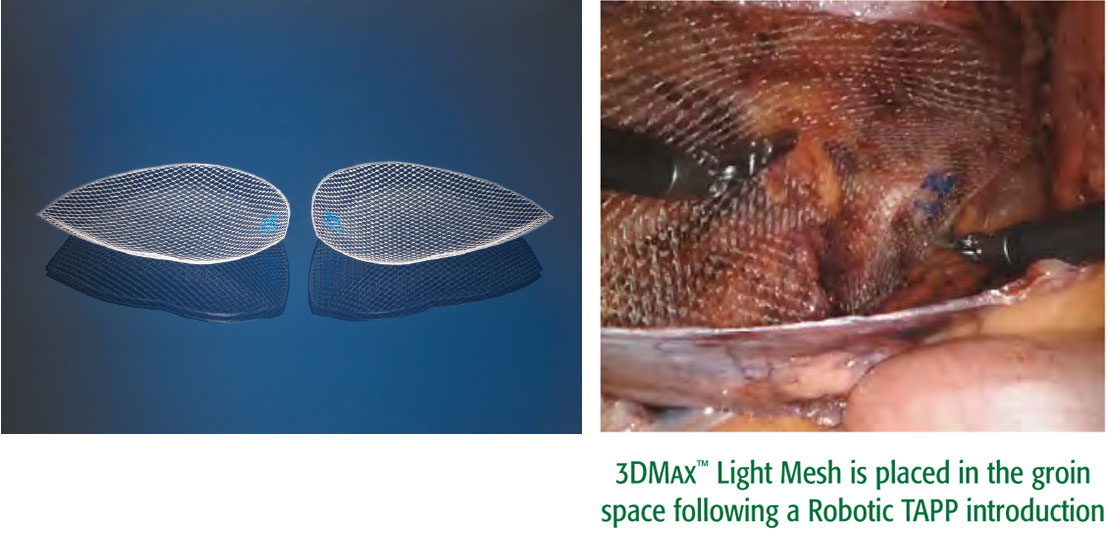BD-121012
3DMax™ Light Mesh
Lighter-weight version of the popular 3DMax™ Mesh, featuring a large pore knit design.


- Overview
- Products & Accessories
- EIFU & Resources
A lightweight 3D-shaped mesh for laparoscopic approaches such as TAPP, TEP and Robotic TAPP
This lighter-weight version of our popular 3DMax™ Mesh features a large pore knit. It is easy to deploy and provides excellent visibility. It is designed to conform to the inguinal anatomy and retains its shape following laparoscopic introduction, including a robotic approach.
Unique
- 3D shape developed by a laparoscopic surgeon.
- Designed to conform to the inguinal anatomy.
- Contour minimizes buckling that may be seen with flat mesh.
- Design may reduce the need for fixation.
Precise
- Sealed edge and medial orientation marker facilitate accurate placement and positioning.
- Built-in memory maintains shape.
- 3DMax™ Light mesh is available in 3 sizes and in both left and right orientation.
Lighter Weight
- Lighter-weight monofilament polypropylene mesh.
- Large pore knit provides excellent visibility.
- Preclinical data demonstrated the formation of a flexible and compliant abdominal wall.1
- TAPP
- TEP
- Robotic TAPP
Indications.
The 3DMax™ Light Mesh is indicated for use in the reinforcement of soft tissue where weakness exists, in the repair of inguinal hernias.
Contraindications.
1. Do not use this mesh in infants, children, or pregnant women, whereby future growth may be compromised by use of such materials.
2. The use of this mesh has not been studied in pregnant or breastfeeding women.
3. Literature reports that there may be a possibility for adhesion formation when polypropylene is placed in direct contact with the bowel or viscera.
Warnings.
1. The use of any synthetic mesh or patch in a contaminated or infected wound can lead to fistula formation and/or extrusion of the mesh.
2. If an infection develops, treat the infection aggressively. Consideration should be given regarding the need to remove the mesh. An unresolved infection may require removal of the mesh.
3. If unused mesh has been in contact with instruments or supplies used on a patient or contaminated with body fluids, discard with care to prevent risk of transmission of viral infections.
4. To prevent recurrences when repairing hernias, the mesh should be sized with appropriate overlap for the size and location of the defect, taking into consideration any additional clinical factors applicable to the patient. Careful attention to mesh fixation placement and spacing will help prevent excessive tension or gap formation between the mesh and fascial tissue.
5. The mesh is supplied sterile. Inspect the packaging to be sure it is intact and undamaged prior to use.
6. This mesh had been designed for single use only. Reuse, reprocessing, resterilization, or repackaging may compromise the structural integrity and/or essential material and design characteristics that are critical to the overall performance of the mesh and may lead to mesh failure which may result in injury to the patient. Reuse, reprocessing, resterilization, or repackaging may also create a risk of contamination of the mesh and/or cause patient infection or cross infection, including, but not limited to, the transmission of infectious diseases from one patient to another. Contamination of the mesh may lead to injury, illness or death of the patient or end user.
7. To avoid injury, careful attention is required if fixating the mesh in the presence of nerves, vessels, or the spermatic cord. Fastener penetration into underlying tissue containing nerves or blood vessels may result in the need for medical/surgical intervention, cause serious injury or permanent impairment to a body structure.
Precautions.
1. Please read all instructions prior to use.
2. Only physicians qualified in appropriate surgical techniques should use this mesh.
3. Do not cut or reshape the 3DMax™ Light Mesh as this may affect its effectiveness.
4. Use an appropriately sized trocar to allow mesh to slide down the trocar with minimal force.
5. If fixation is used, Bard® permanent or absorbable fixation devices or nonabsorbable monofilament sutures are recommended to properly secure the device. If other fixation devices are used, they must be indicated for use in hernia repair.
6. If fixation is used, care should be taken to ensure that the mesh is adequately fixated to the abdominal wall. If necessary, additional fasteners and/or sutures should be used.
Adverse Reactions.
Possible complications may include, but are not limited to, seroma, adhesions, hematomas, pain, infection, inflammation, extrusion, erosion, migration, fistula formation, allergic reaction and recurrence of the hernia or soft tissue defect.
Please consult product package insert for more detailed safety information and instructions for use.
Please consult package insert for more detailed safety information and instructions for use.
Indications.
The 3DMax™ Light Mesh is indicated for use in the reinforcement of soft tissue where weakness exists, in the repair of inguinal hernias.
Contraindications.
1. Do not use this mesh in infants, children, or pregnant women, whereby future growth may be compromised by use of such materials.
2. The use of this mesh has not been studied in pregnant or breastfeeding women.
3. Literature reports that there may be a possibility for adhesion formation when polypropylene is placed in direct contact with the bowel or viscera.
Warnings.
1. The use of any synthetic mesh or patch in a contaminated or infected wound can lead to fistula formation and/or extrusion of the mesh.
2. If an infection develops, treat the infection aggressively. Consideration should be given regarding the need to remove the mesh. An unresolved infection may require removal of the mesh.
3. If unused mesh has been in contact with instruments or supplies used on a patient or contaminated with body fluids, discard with care to prevent risk of transmission of viral infections.
4. To prevent recurrences when repairing hernias, the mesh should be sized with appropriate overlap for the size and location of the defect, taking into consideration any additional clinical factors applicable to the patient. Careful attention to mesh fixation placement and spacing will help prevent excessive tension or gap formation between the mesh and fascial tissue.
5. The mesh is supplied sterile. Inspect the packaging to be sure it is intact and undamaged prior to use.
6. This mesh had been designed for single use only. Reuse, reprocessing, resterilization, or repackaging may compromise the structural integrity and/or essential material and design characteristics that are critical to the overall performance of the mesh and may lead to mesh failure which may result in injury to the patient. Reuse, reprocessing, resterilization, or repackaging may also create a risk of contamination of the mesh and/or cause patient infection or cross infection, including, but not limited to, the transmission of infectious diseases from one patient to another. Contamination of the mesh may lead to injury, illness or death of the patient or end user.
7. To avoid injury, careful attention is required if fixating the mesh in the presence of nerves, vessels, or the spermatic cord. Fastener penetration into underlying tissue containing nerves or blood vessels may result in the need for medical/surgical intervention, cause serious injury or permanent impairment to a body structure.
Precautions.
1. Please read all instructions prior to use.
2. Only physicians qualified in appropriate surgical techniques should use this mesh.
3. Do not cut or reshape the 3DMax™ Light Mesh as this may affect its effectiveness.
4. Use an appropriately sized trocar to allow mesh to slide down the trocar with minimal force.
5. If fixation is used, Bard® permanent or absorbable fixation devices or nonabsorbable monofilament sutures are recommended to properly secure the device. If other fixation devices are used, they must be indicated for use in hernia repair.
6. If fixation is used, care should be taken to ensure that the mesh is adequately fixated to the abdominal wall. If necessary, additional fasteners and/or sutures should be used.
Adverse Reactions.
Possible complications may include, but are not limited to, seroma, adhesions, hematomas, pain, infection, inflammation, extrusion, erosion, migration, fistula formation, allergic reaction and recurrence of the hernia or soft tissue defect.
Please consult product package insert for more detailed safety information and instructions for use.
Please consult package insert for more detailed safety information and instructions for use.
Our collection of literature on industries and on our offerings gives you information you can use to continue striving for excellence.
We support the healthcare industry with market-leading products and services that aim to improve care while lowering costs. We host and take part in events that excel in advancing the world of health™.
The BD Learning Academy offers a centralized repository of BD product training, education, and the ability to connect courses to your LMS.
We promote clinical excellence by providing various resources on best practices, clinical innovations and industry trends in healthcare.
Indications.
The 3DMax™ Light Mesh is indicated for use in the reinforcement of soft tissue where weakness exists, in the repair of inguinal hernias.
Contraindications.
1. Do not use this mesh in infants, children, or pregnant women, whereby future growth may be compromised by use of such materials.
2. The use of this mesh has not been studied in pregnant or breastfeeding women.
3. Literature reports that there may be a possibility for adhesion formation when polypropylene is placed in direct contact with the bowel or viscera.
Warnings.
1. The use of any synthetic mesh or patch in a contaminated or infected wound can lead to fistula formation and/or extrusion of the mesh.
2. If an infection develops, treat the infection aggressively. Consideration should be given regarding the need to remove the mesh. An unresolved infection may require removal of the mesh.
3. If unused mesh has been in contact with instruments or supplies used on a patient or contaminated with body fluids, discard with care to prevent risk of transmission of viral infections.
4. To prevent recurrences when repairing hernias, the mesh should be sized with appropriate overlap for the size and location of the defect, taking into consideration any additional clinical factors applicable to the patient. Careful attention to mesh fixation placement and spacing will help prevent excessive tension or gap formation between the mesh and fascial tissue.
5. The mesh is supplied sterile. Inspect the packaging to be sure it is intact and undamaged prior to use.
6. This mesh had been designed for single use only. Reuse, reprocessing, resterilization, or repackaging may compromise the structural integrity and/or essential material and design characteristics that are critical to the overall performance of the mesh and may lead to mesh failure which may result in injury to the patient. Reuse, reprocessing, resterilization, or repackaging may also create a risk of contamination of the mesh and/or cause patient infection or cross infection, including, but not limited to, the transmission of infectious diseases from one patient to another. Contamination of the mesh may lead to injury, illness or death of the patient or end user.
7. To avoid injury, careful attention is required if fixating the mesh in the presence of nerves, vessels, or the spermatic cord. Fastener penetration into underlying tissue containing nerves or blood vessels may result in the need for medical/surgical intervention, cause serious injury or permanent impairment to a body structure.
Precautions.
1. Please read all instructions prior to use.
2. Only physicians qualified in appropriate surgical techniques should use this mesh.
3. Do not cut or reshape the 3DMax™ Light Mesh as this may affect its effectiveness.
4. Use an appropriately sized trocar to allow mesh to slide down the trocar with minimal force.
5. If fixation is used, Bard® permanent or absorbable fixation devices or nonabsorbable monofilament sutures are recommended to properly secure the device. If other fixation devices are used, they must be indicated for use in hernia repair.
6. If fixation is used, care should be taken to ensure that the mesh is adequately fixated to the abdominal wall. If necessary, additional fasteners and/or sutures should be used.
Adverse Reactions.
Possible complications may include, but are not limited to, seroma, adhesions, hematomas, pain, infection, inflammation, extrusion, erosion, migration, fistula formation, allergic reaction and recurrence of the hernia or soft tissue defect.
Please consult product package insert for more detailed safety information and instructions for use.
Please consult package insert for more detailed safety information and instructions for use.



